Trends in the Horticulture Sector in Australia: A Case Study of Costa
VerifiedAdded on 2023/04/03
|13
|2423
|328
AI Summary
This report discusses the trends in the horticulture sector in Australia and analyzes the business operation of Costa, the largest horticulture company in the country. It identifies the major external factors affecting Costa's long-term viability and evaluates its internal capabilities and sources of competitive advantage. The report also provides recommendations for enhancing Costa's business in the long term.
Contribute Materials
Your contribution can guide someone’s learning journey. Share your
documents today.
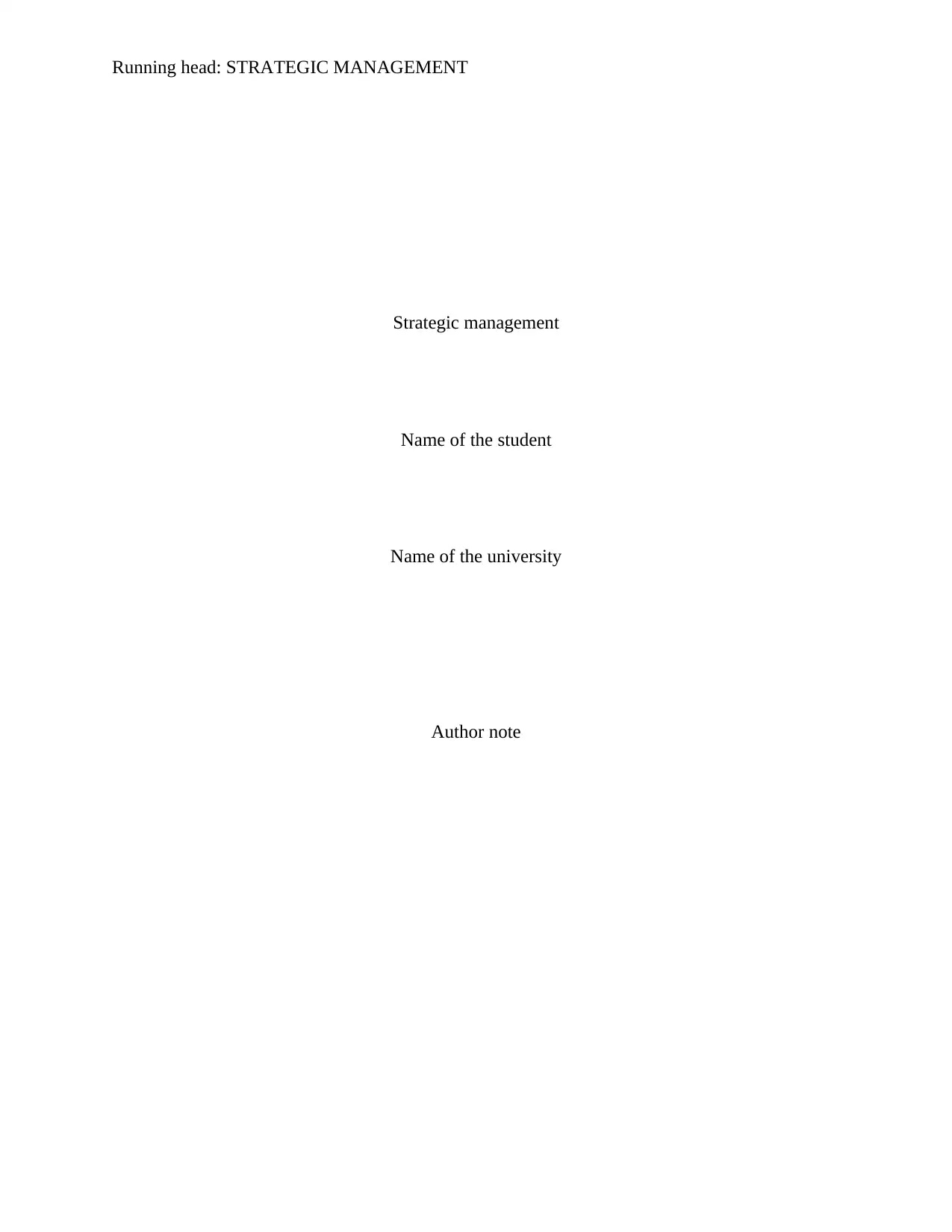
Running head: STRATEGIC MANAGEMENT
Strategic management
Name of the student
Name of the university
Author note
Strategic management
Name of the student
Name of the university
Author note
Secure Best Marks with AI Grader
Need help grading? Try our AI Grader for instant feedback on your assignments.
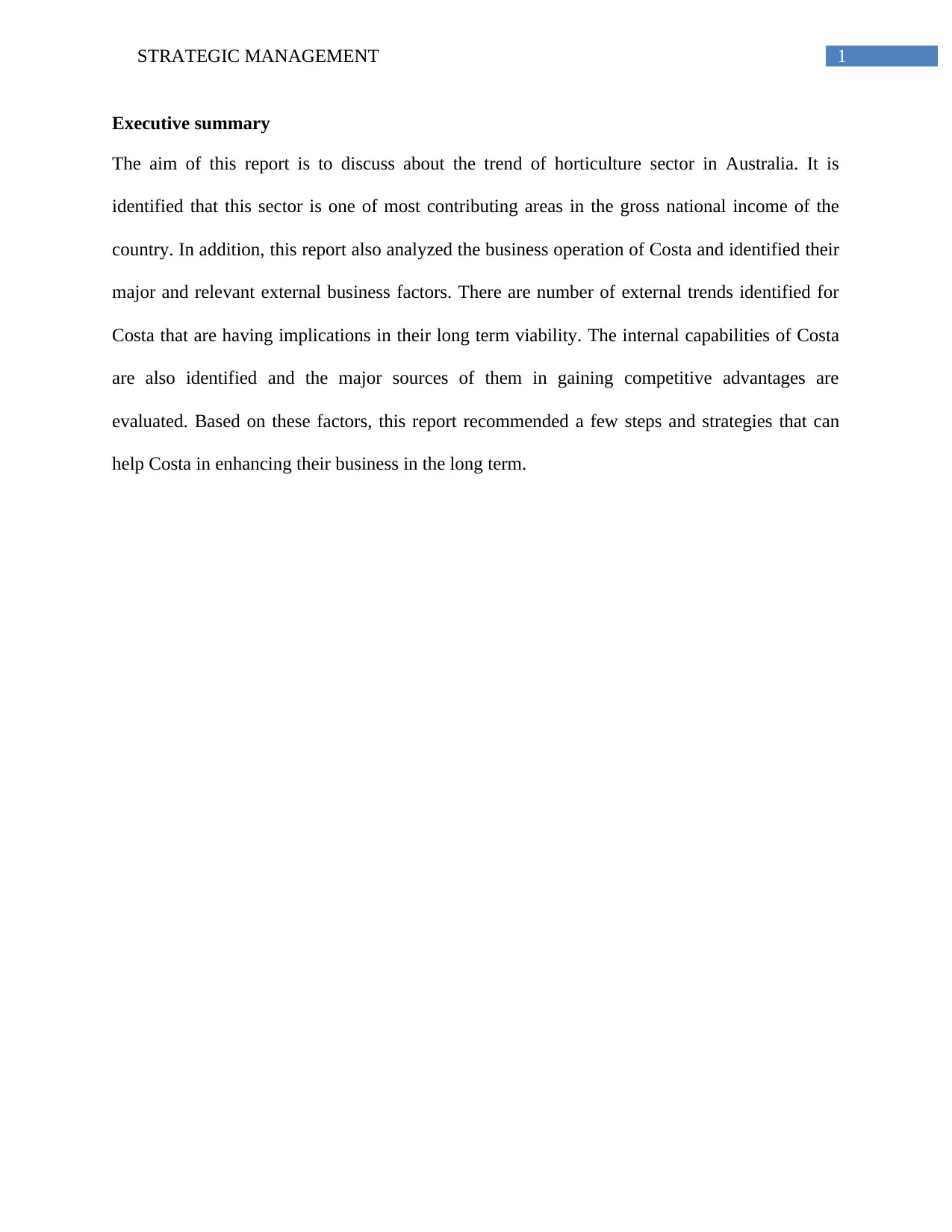
1STRATEGIC MANAGEMENT
Executive summary
The aim of this report is to discuss about the trend of horticulture sector in Australia. It is
identified that this sector is one of most contributing areas in the gross national income of the
country. In addition, this report also analyzed the business operation of Costa and identified their
major and relevant external business factors. There are number of external trends identified for
Costa that are having implications in their long term viability. The internal capabilities of Costa
are also identified and the major sources of them in gaining competitive advantages are
evaluated. Based on these factors, this report recommended a few steps and strategies that can
help Costa in enhancing their business in the long term.
Executive summary
The aim of this report is to discuss about the trend of horticulture sector in Australia. It is
identified that this sector is one of most contributing areas in the gross national income of the
country. In addition, this report also analyzed the business operation of Costa and identified their
major and relevant external business factors. There are number of external trends identified for
Costa that are having implications in their long term viability. The internal capabilities of Costa
are also identified and the major sources of them in gaining competitive advantages are
evaluated. Based on these factors, this report recommended a few steps and strategies that can
help Costa in enhancing their business in the long term.
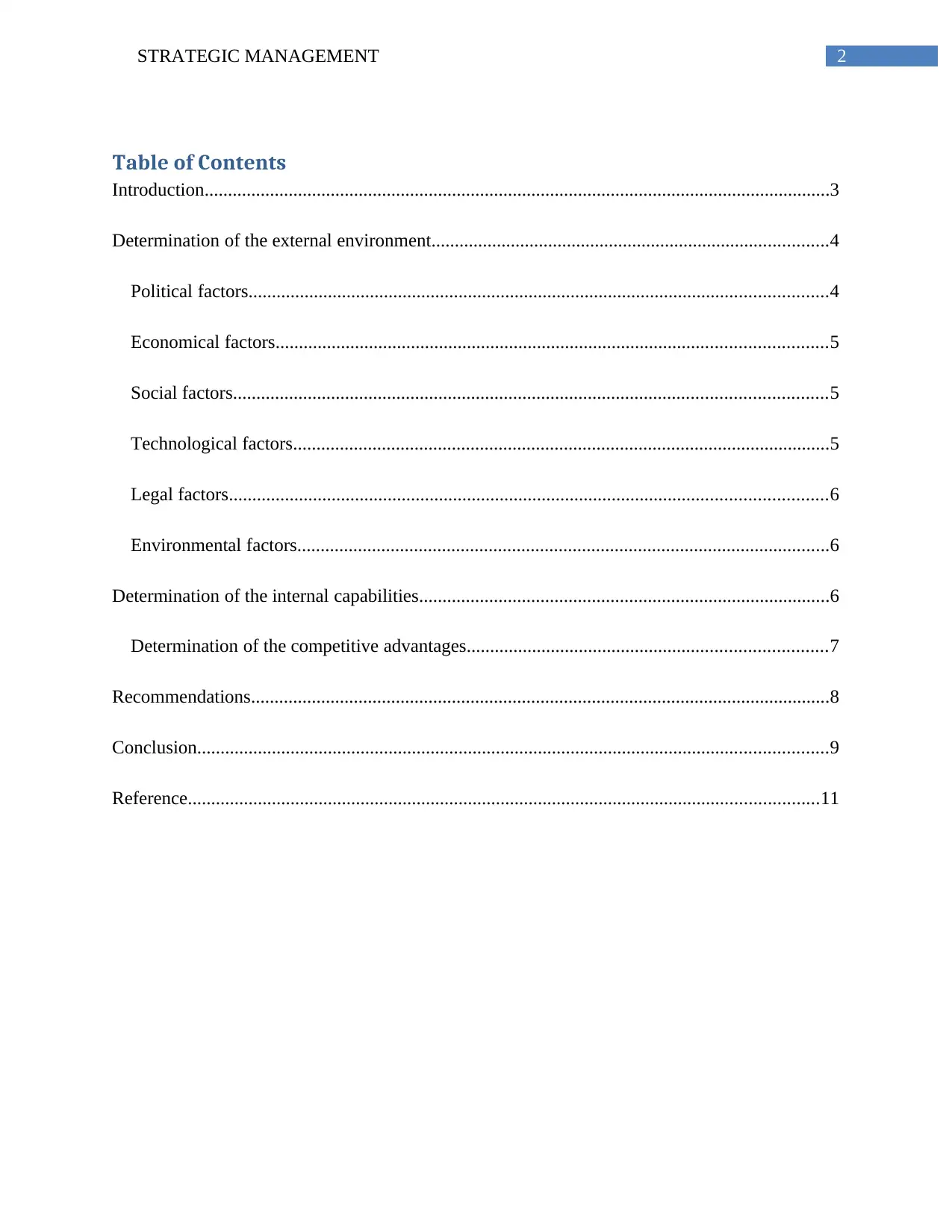
2STRATEGIC MANAGEMENT
Table of Contents
Introduction......................................................................................................................................3
Determination of the external environment.....................................................................................4
Political factors............................................................................................................................4
Economical factors......................................................................................................................5
Social factors...............................................................................................................................5
Technological factors...................................................................................................................5
Legal factors................................................................................................................................6
Environmental factors..................................................................................................................6
Determination of the internal capabilities........................................................................................6
Determination of the competitive advantages.............................................................................7
Recommendations............................................................................................................................8
Conclusion.......................................................................................................................................9
Reference.......................................................................................................................................11
Table of Contents
Introduction......................................................................................................................................3
Determination of the external environment.....................................................................................4
Political factors............................................................................................................................4
Economical factors......................................................................................................................5
Social factors...............................................................................................................................5
Technological factors...................................................................................................................5
Legal factors................................................................................................................................6
Environmental factors..................................................................................................................6
Determination of the internal capabilities........................................................................................6
Determination of the competitive advantages.............................................................................7
Recommendations............................................................................................................................8
Conclusion.......................................................................................................................................9
Reference.......................................................................................................................................11
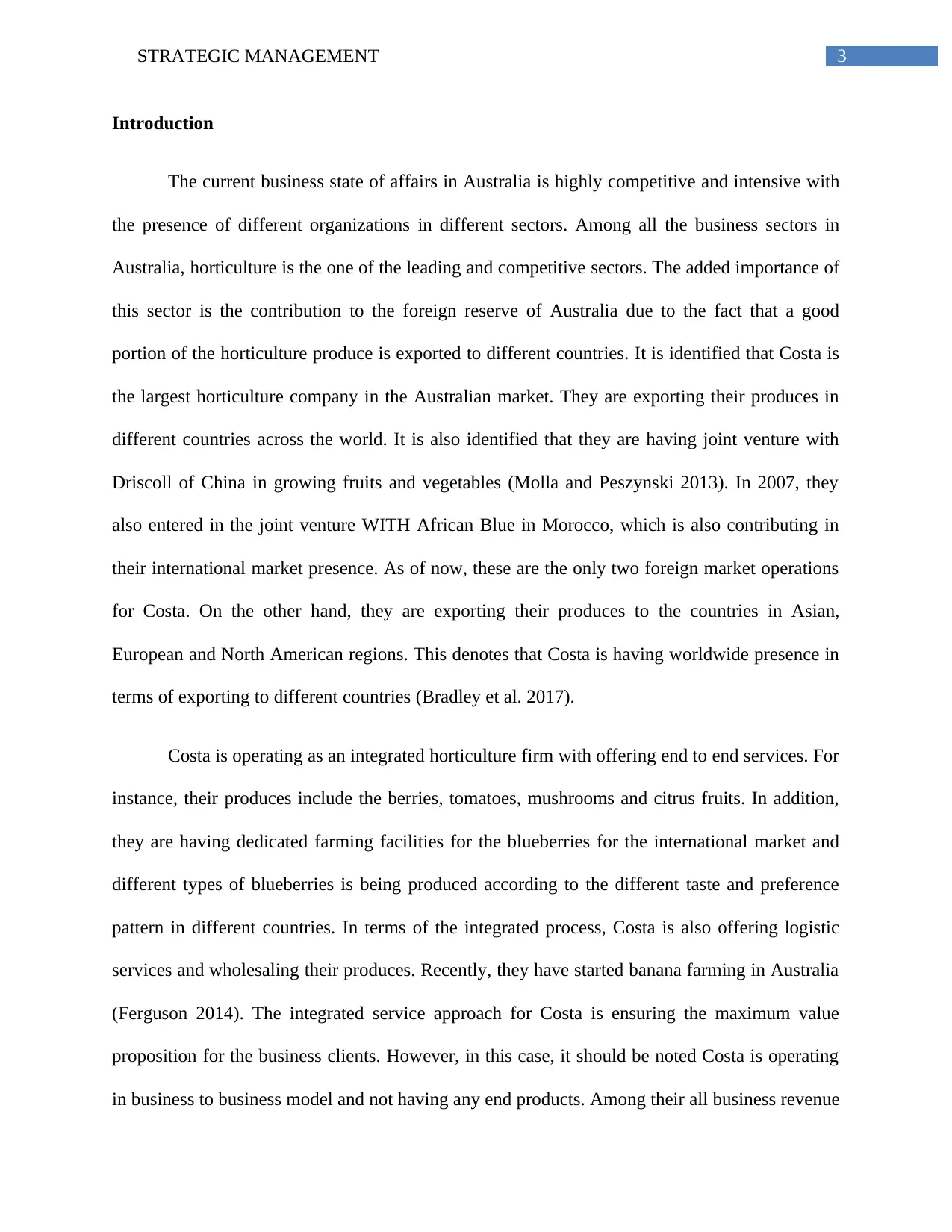
3STRATEGIC MANAGEMENT
Introduction
The current business state of affairs in Australia is highly competitive and intensive with
the presence of different organizations in different sectors. Among all the business sectors in
Australia, horticulture is the one of the leading and competitive sectors. The added importance of
this sector is the contribution to the foreign reserve of Australia due to the fact that a good
portion of the horticulture produce is exported to different countries. It is identified that Costa is
the largest horticulture company in the Australian market. They are exporting their produces in
different countries across the world. It is also identified that they are having joint venture with
Driscoll of China in growing fruits and vegetables (Molla and Peszynski 2013). In 2007, they
also entered in the joint venture WITH African Blue in Morocco, which is also contributing in
their international market presence. As of now, these are the only two foreign market operations
for Costa. On the other hand, they are exporting their produces to the countries in Asian,
European and North American regions. This denotes that Costa is having worldwide presence in
terms of exporting to different countries (Bradley et al. 2017).
Costa is operating as an integrated horticulture firm with offering end to end services. For
instance, their produces include the berries, tomatoes, mushrooms and citrus fruits. In addition,
they are having dedicated farming facilities for the blueberries for the international market and
different types of blueberries is being produced according to the different taste and preference
pattern in different countries. In terms of the integrated process, Costa is also offering logistic
services and wholesaling their produces. Recently, they have started banana farming in Australia
(Ferguson 2014). The integrated service approach for Costa is ensuring the maximum value
proposition for the business clients. However, in this case, it should be noted Costa is operating
in business to business model and not having any end products. Among their all business revenue
Introduction
The current business state of affairs in Australia is highly competitive and intensive with
the presence of different organizations in different sectors. Among all the business sectors in
Australia, horticulture is the one of the leading and competitive sectors. The added importance of
this sector is the contribution to the foreign reserve of Australia due to the fact that a good
portion of the horticulture produce is exported to different countries. It is identified that Costa is
the largest horticulture company in the Australian market. They are exporting their produces in
different countries across the world. It is also identified that they are having joint venture with
Driscoll of China in growing fruits and vegetables (Molla and Peszynski 2013). In 2007, they
also entered in the joint venture WITH African Blue in Morocco, which is also contributing in
their international market presence. As of now, these are the only two foreign market operations
for Costa. On the other hand, they are exporting their produces to the countries in Asian,
European and North American regions. This denotes that Costa is having worldwide presence in
terms of exporting to different countries (Bradley et al. 2017).
Costa is operating as an integrated horticulture firm with offering end to end services. For
instance, their produces include the berries, tomatoes, mushrooms and citrus fruits. In addition,
they are having dedicated farming facilities for the blueberries for the international market and
different types of blueberries is being produced according to the different taste and preference
pattern in different countries. In terms of the integrated process, Costa is also offering logistic
services and wholesaling their produces. Recently, they have started banana farming in Australia
(Ferguson 2014). The integrated service approach for Costa is ensuring the maximum value
proposition for the business clients. However, in this case, it should be noted Costa is operating
in business to business model and not having any end products. Among their all business revenue
Secure Best Marks with AI Grader
Need help grading? Try our AI Grader for instant feedback on your assignments.
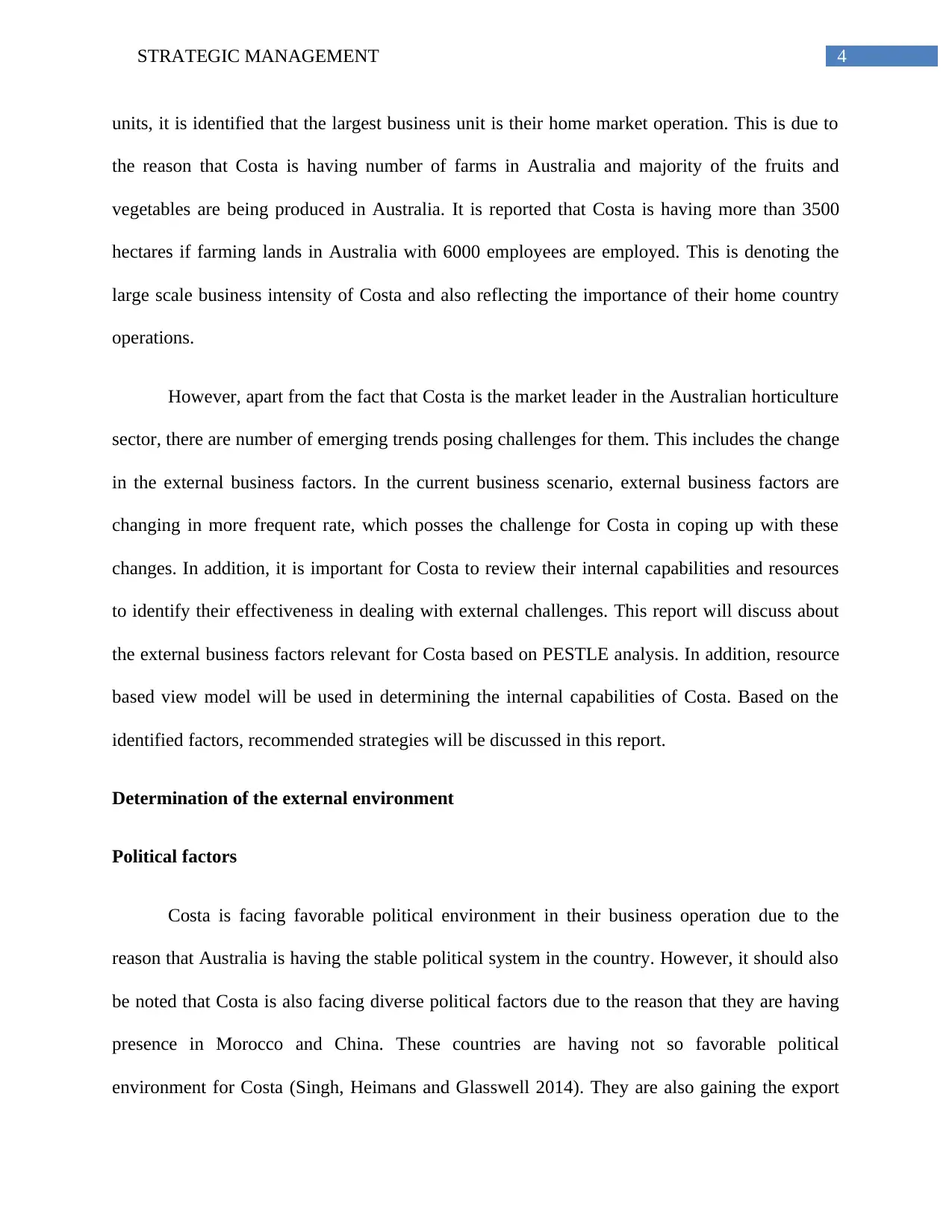
4STRATEGIC MANAGEMENT
units, it is identified that the largest business unit is their home market operation. This is due to
the reason that Costa is having number of farms in Australia and majority of the fruits and
vegetables are being produced in Australia. It is reported that Costa is having more than 3500
hectares if farming lands in Australia with 6000 employees are employed. This is denoting the
large scale business intensity of Costa and also reflecting the importance of their home country
operations.
However, apart from the fact that Costa is the market leader in the Australian horticulture
sector, there are number of emerging trends posing challenges for them. This includes the change
in the external business factors. In the current business scenario, external business factors are
changing in more frequent rate, which posses the challenge for Costa in coping up with these
changes. In addition, it is important for Costa to review their internal capabilities and resources
to identify their effectiveness in dealing with external challenges. This report will discuss about
the external business factors relevant for Costa based on PESTLE analysis. In addition, resource
based view model will be used in determining the internal capabilities of Costa. Based on the
identified factors, recommended strategies will be discussed in this report.
Determination of the external environment
Political factors
Costa is facing favorable political environment in their business operation due to the
reason that Australia is having the stable political system in the country. However, it should also
be noted that Costa is also facing diverse political factors due to the reason that they are having
presence in Morocco and China. These countries are having not so favorable political
environment for Costa (Singh, Heimans and Glasswell 2014). They are also gaining the export
units, it is identified that the largest business unit is their home market operation. This is due to
the reason that Costa is having number of farms in Australia and majority of the fruits and
vegetables are being produced in Australia. It is reported that Costa is having more than 3500
hectares if farming lands in Australia with 6000 employees are employed. This is denoting the
large scale business intensity of Costa and also reflecting the importance of their home country
operations.
However, apart from the fact that Costa is the market leader in the Australian horticulture
sector, there are number of emerging trends posing challenges for them. This includes the change
in the external business factors. In the current business scenario, external business factors are
changing in more frequent rate, which posses the challenge for Costa in coping up with these
changes. In addition, it is important for Costa to review their internal capabilities and resources
to identify their effectiveness in dealing with external challenges. This report will discuss about
the external business factors relevant for Costa based on PESTLE analysis. In addition, resource
based view model will be used in determining the internal capabilities of Costa. Based on the
identified factors, recommended strategies will be discussed in this report.
Determination of the external environment
Political factors
Costa is facing favorable political environment in their business operation due to the
reason that Australia is having the stable political system in the country. However, it should also
be noted that Costa is also facing diverse political factors due to the reason that they are having
presence in Morocco and China. These countries are having not so favorable political
environment for Costa (Singh, Heimans and Glasswell 2014). They are also gaining the export
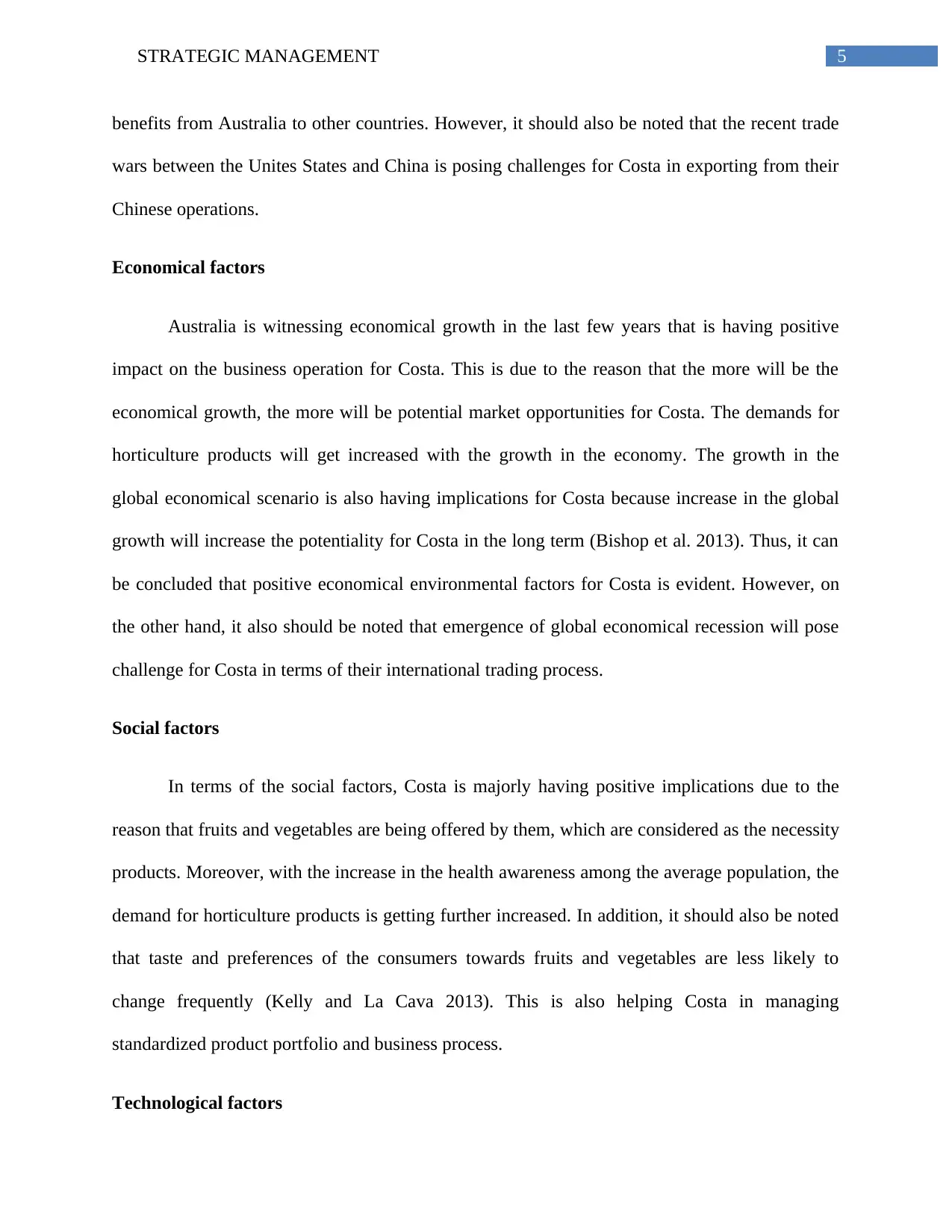
5STRATEGIC MANAGEMENT
benefits from Australia to other countries. However, it should also be noted that the recent trade
wars between the Unites States and China is posing challenges for Costa in exporting from their
Chinese operations.
Economical factors
Australia is witnessing economical growth in the last few years that is having positive
impact on the business operation for Costa. This is due to the reason that the more will be the
economical growth, the more will be potential market opportunities for Costa. The demands for
horticulture products will get increased with the growth in the economy. The growth in the
global economical scenario is also having implications for Costa because increase in the global
growth will increase the potentiality for Costa in the long term (Bishop et al. 2013). Thus, it can
be concluded that positive economical environmental factors for Costa is evident. However, on
the other hand, it also should be noted that emergence of global economical recession will pose
challenge for Costa in terms of their international trading process.
Social factors
In terms of the social factors, Costa is majorly having positive implications due to the
reason that fruits and vegetables are being offered by them, which are considered as the necessity
products. Moreover, with the increase in the health awareness among the average population, the
demand for horticulture products is getting further increased. In addition, it should also be noted
that taste and preferences of the consumers towards fruits and vegetables are less likely to
change frequently (Kelly and La Cava 2013). This is also helping Costa in managing
standardized product portfolio and business process.
Technological factors
benefits from Australia to other countries. However, it should also be noted that the recent trade
wars between the Unites States and China is posing challenges for Costa in exporting from their
Chinese operations.
Economical factors
Australia is witnessing economical growth in the last few years that is having positive
impact on the business operation for Costa. This is due to the reason that the more will be the
economical growth, the more will be potential market opportunities for Costa. The demands for
horticulture products will get increased with the growth in the economy. The growth in the
global economical scenario is also having implications for Costa because increase in the global
growth will increase the potentiality for Costa in the long term (Bishop et al. 2013). Thus, it can
be concluded that positive economical environmental factors for Costa is evident. However, on
the other hand, it also should be noted that emergence of global economical recession will pose
challenge for Costa in terms of their international trading process.
Social factors
In terms of the social factors, Costa is majorly having positive implications due to the
reason that fruits and vegetables are being offered by them, which are considered as the necessity
products. Moreover, with the increase in the health awareness among the average population, the
demand for horticulture products is getting further increased. In addition, it should also be noted
that taste and preferences of the consumers towards fruits and vegetables are less likely to
change frequently (Kelly and La Cava 2013). This is also helping Costa in managing
standardized product portfolio and business process.
Technological factors
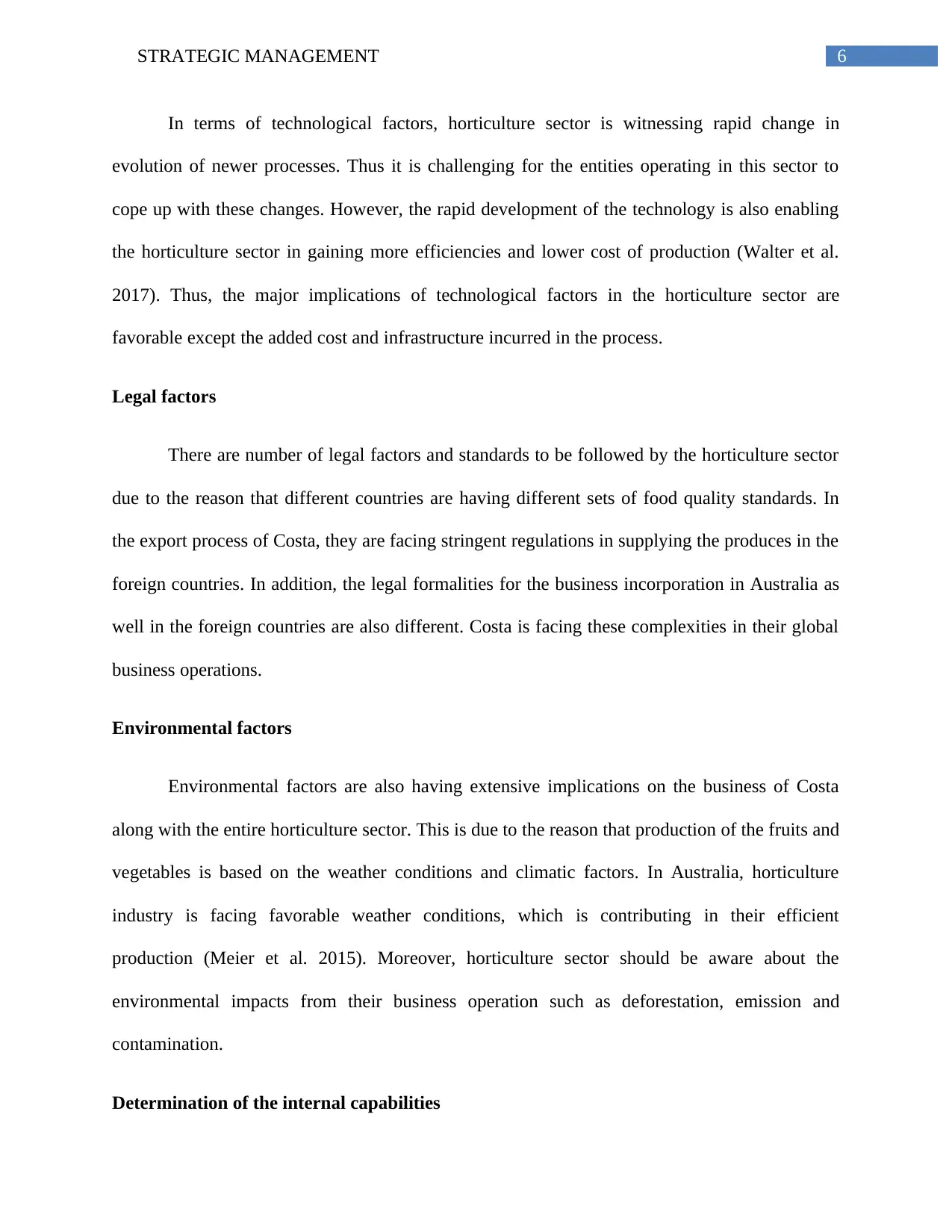
6STRATEGIC MANAGEMENT
In terms of technological factors, horticulture sector is witnessing rapid change in
evolution of newer processes. Thus it is challenging for the entities operating in this sector to
cope up with these changes. However, the rapid development of the technology is also enabling
the horticulture sector in gaining more efficiencies and lower cost of production (Walter et al.
2017). Thus, the major implications of technological factors in the horticulture sector are
favorable except the added cost and infrastructure incurred in the process.
Legal factors
There are number of legal factors and standards to be followed by the horticulture sector
due to the reason that different countries are having different sets of food quality standards. In
the export process of Costa, they are facing stringent regulations in supplying the produces in the
foreign countries. In addition, the legal formalities for the business incorporation in Australia as
well in the foreign countries are also different. Costa is facing these complexities in their global
business operations.
Environmental factors
Environmental factors are also having extensive implications on the business of Costa
along with the entire horticulture sector. This is due to the reason that production of the fruits and
vegetables is based on the weather conditions and climatic factors. In Australia, horticulture
industry is facing favorable weather conditions, which is contributing in their efficient
production (Meier et al. 2015). Moreover, horticulture sector should be aware about the
environmental impacts from their business operation such as deforestation, emission and
contamination.
Determination of the internal capabilities
In terms of technological factors, horticulture sector is witnessing rapid change in
evolution of newer processes. Thus it is challenging for the entities operating in this sector to
cope up with these changes. However, the rapid development of the technology is also enabling
the horticulture sector in gaining more efficiencies and lower cost of production (Walter et al.
2017). Thus, the major implications of technological factors in the horticulture sector are
favorable except the added cost and infrastructure incurred in the process.
Legal factors
There are number of legal factors and standards to be followed by the horticulture sector
due to the reason that different countries are having different sets of food quality standards. In
the export process of Costa, they are facing stringent regulations in supplying the produces in the
foreign countries. In addition, the legal formalities for the business incorporation in Australia as
well in the foreign countries are also different. Costa is facing these complexities in their global
business operations.
Environmental factors
Environmental factors are also having extensive implications on the business of Costa
along with the entire horticulture sector. This is due to the reason that production of the fruits and
vegetables is based on the weather conditions and climatic factors. In Australia, horticulture
industry is facing favorable weather conditions, which is contributing in their efficient
production (Meier et al. 2015). Moreover, horticulture sector should be aware about the
environmental impacts from their business operation such as deforestation, emission and
contamination.
Determination of the internal capabilities
Paraphrase This Document
Need a fresh take? Get an instant paraphrase of this document with our AI Paraphraser
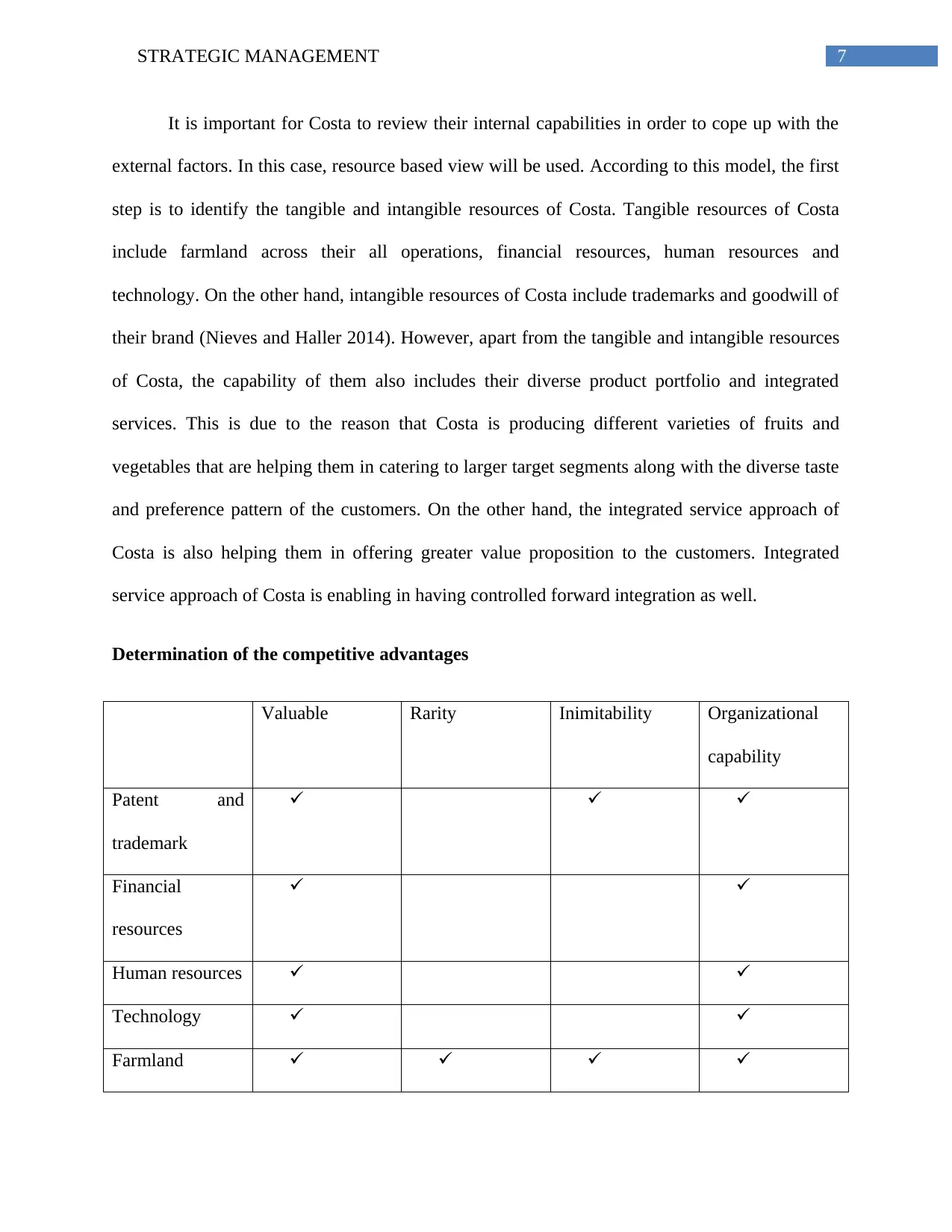
7STRATEGIC MANAGEMENT
It is important for Costa to review their internal capabilities in order to cope up with the
external factors. In this case, resource based view will be used. According to this model, the first
step is to identify the tangible and intangible resources of Costa. Tangible resources of Costa
include farmland across their all operations, financial resources, human resources and
technology. On the other hand, intangible resources of Costa include trademarks and goodwill of
their brand (Nieves and Haller 2014). However, apart from the tangible and intangible resources
of Costa, the capability of them also includes their diverse product portfolio and integrated
services. This is due to the reason that Costa is producing different varieties of fruits and
vegetables that are helping them in catering to larger target segments along with the diverse taste
and preference pattern of the customers. On the other hand, the integrated service approach of
Costa is also helping them in offering greater value proposition to the customers. Integrated
service approach of Costa is enabling in having controlled forward integration as well.
Determination of the competitive advantages
Valuable Rarity Inimitability Organizational
capability
Patent and
trademark
Financial
resources
Human resources
Technology
Farmland
It is important for Costa to review their internal capabilities in order to cope up with the
external factors. In this case, resource based view will be used. According to this model, the first
step is to identify the tangible and intangible resources of Costa. Tangible resources of Costa
include farmland across their all operations, financial resources, human resources and
technology. On the other hand, intangible resources of Costa include trademarks and goodwill of
their brand (Nieves and Haller 2014). However, apart from the tangible and intangible resources
of Costa, the capability of them also includes their diverse product portfolio and integrated
services. This is due to the reason that Costa is producing different varieties of fruits and
vegetables that are helping them in catering to larger target segments along with the diverse taste
and preference pattern of the customers. On the other hand, the integrated service approach of
Costa is also helping them in offering greater value proposition to the customers. Integrated
service approach of Costa is enabling in having controlled forward integration as well.
Determination of the competitive advantages
Valuable Rarity Inimitability Organizational
capability
Patent and
trademark
Financial
resources
Human resources
Technology
Farmland
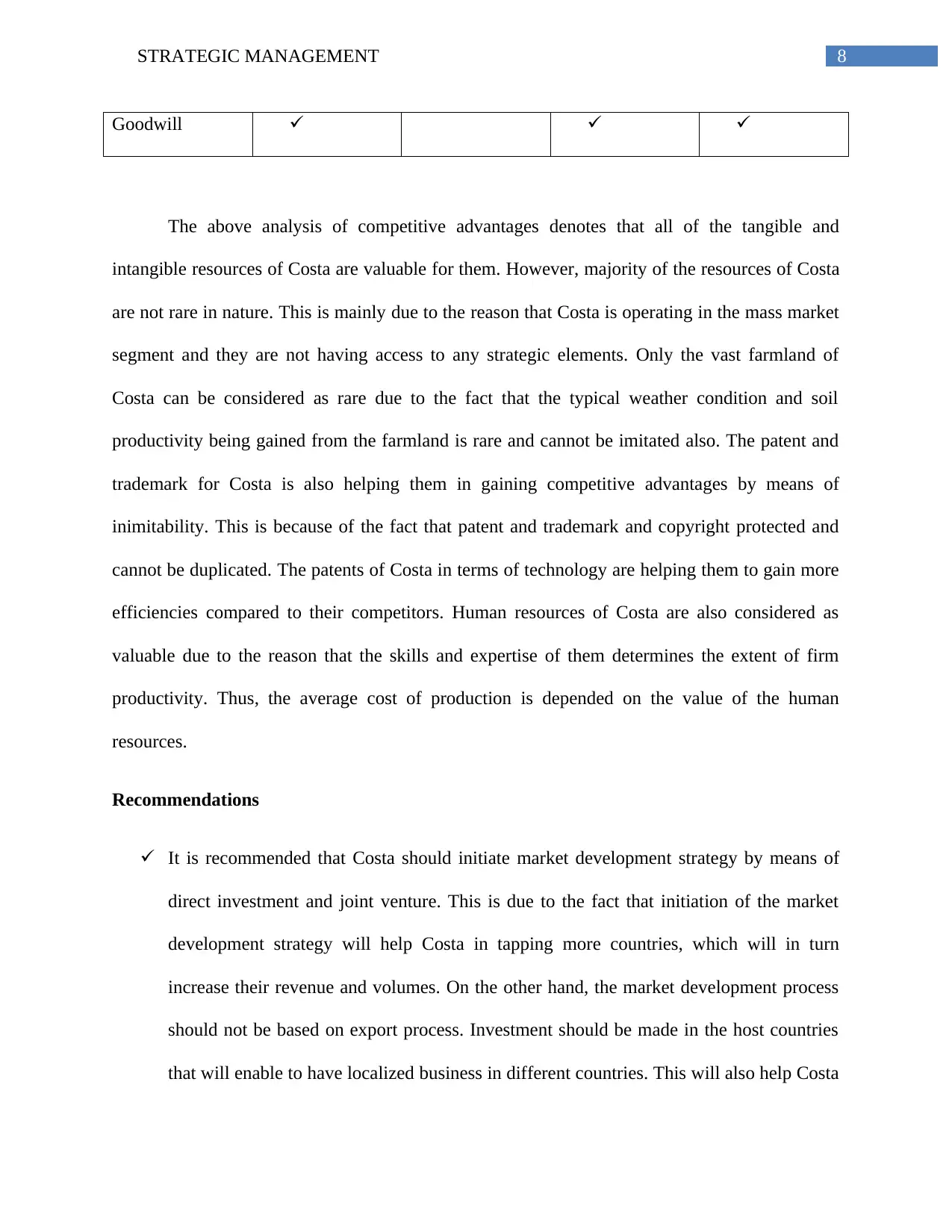
8STRATEGIC MANAGEMENT
Goodwill
The above analysis of competitive advantages denotes that all of the tangible and
intangible resources of Costa are valuable for them. However, majority of the resources of Costa
are not rare in nature. This is mainly due to the reason that Costa is operating in the mass market
segment and they are not having access to any strategic elements. Only the vast farmland of
Costa can be considered as rare due to the fact that the typical weather condition and soil
productivity being gained from the farmland is rare and cannot be imitated also. The patent and
trademark for Costa is also helping them in gaining competitive advantages by means of
inimitability. This is because of the fact that patent and trademark and copyright protected and
cannot be duplicated. The patents of Costa in terms of technology are helping them to gain more
efficiencies compared to their competitors. Human resources of Costa are also considered as
valuable due to the reason that the skills and expertise of them determines the extent of firm
productivity. Thus, the average cost of production is depended on the value of the human
resources.
Recommendations
It is recommended that Costa should initiate market development strategy by means of
direct investment and joint venture. This is due to the fact that initiation of the market
development strategy will help Costa in tapping more countries, which will in turn
increase their revenue and volumes. On the other hand, the market development process
should not be based on export process. Investment should be made in the host countries
that will enable to have localized business in different countries. This will also help Costa
Goodwill
The above analysis of competitive advantages denotes that all of the tangible and
intangible resources of Costa are valuable for them. However, majority of the resources of Costa
are not rare in nature. This is mainly due to the reason that Costa is operating in the mass market
segment and they are not having access to any strategic elements. Only the vast farmland of
Costa can be considered as rare due to the fact that the typical weather condition and soil
productivity being gained from the farmland is rare and cannot be imitated also. The patent and
trademark for Costa is also helping them in gaining competitive advantages by means of
inimitability. This is because of the fact that patent and trademark and copyright protected and
cannot be duplicated. The patents of Costa in terms of technology are helping them to gain more
efficiencies compared to their competitors. Human resources of Costa are also considered as
valuable due to the reason that the skills and expertise of them determines the extent of firm
productivity. Thus, the average cost of production is depended on the value of the human
resources.
Recommendations
It is recommended that Costa should initiate market development strategy by means of
direct investment and joint venture. This is due to the fact that initiation of the market
development strategy will help Costa in tapping more countries, which will in turn
increase their revenue and volumes. On the other hand, the market development process
should not be based on export process. Investment should be made in the host countries
that will enable to have localized business in different countries. This will also help Costa
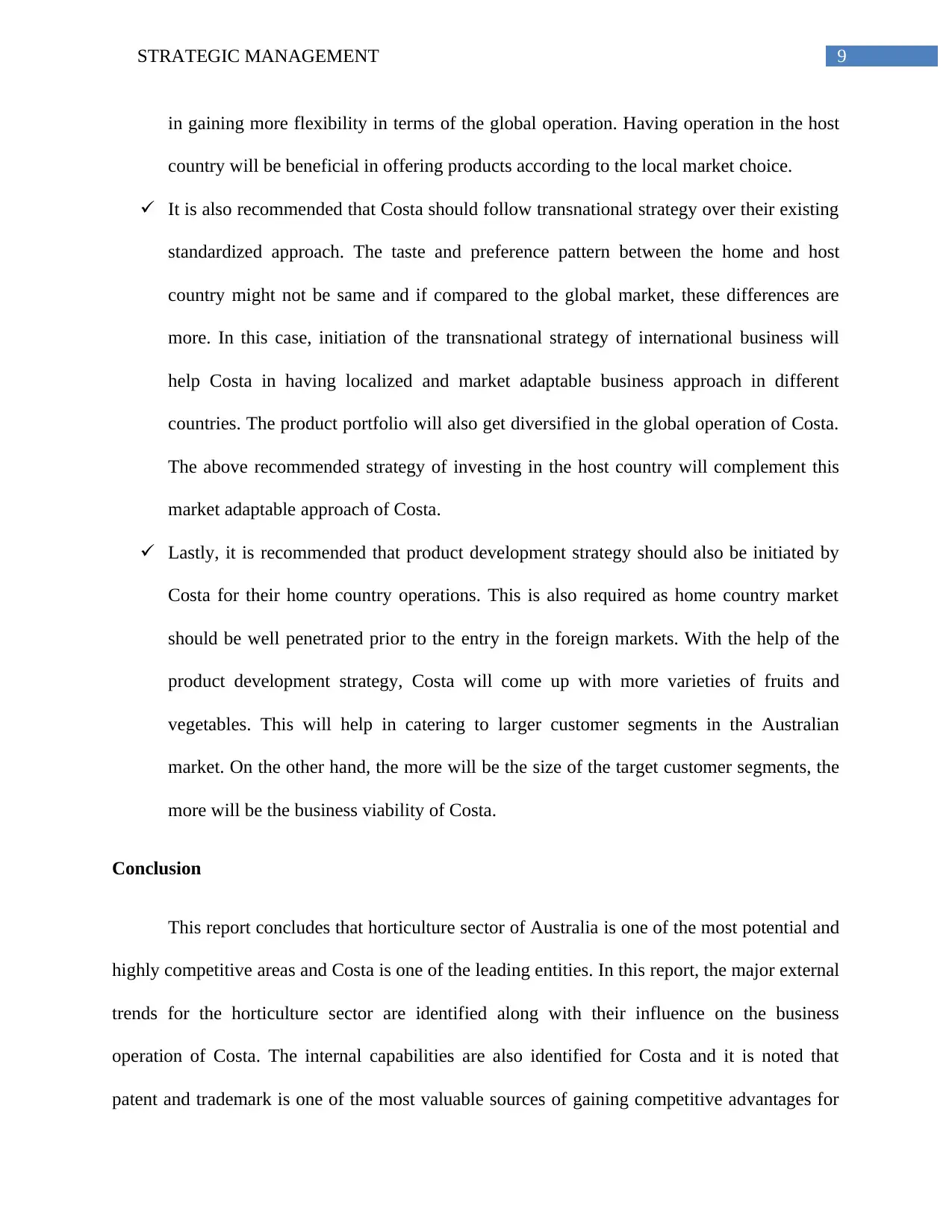
9STRATEGIC MANAGEMENT
in gaining more flexibility in terms of the global operation. Having operation in the host
country will be beneficial in offering products according to the local market choice.
It is also recommended that Costa should follow transnational strategy over their existing
standardized approach. The taste and preference pattern between the home and host
country might not be same and if compared to the global market, these differences are
more. In this case, initiation of the transnational strategy of international business will
help Costa in having localized and market adaptable business approach in different
countries. The product portfolio will also get diversified in the global operation of Costa.
The above recommended strategy of investing in the host country will complement this
market adaptable approach of Costa.
Lastly, it is recommended that product development strategy should also be initiated by
Costa for their home country operations. This is also required as home country market
should be well penetrated prior to the entry in the foreign markets. With the help of the
product development strategy, Costa will come up with more varieties of fruits and
vegetables. This will help in catering to larger customer segments in the Australian
market. On the other hand, the more will be the size of the target customer segments, the
more will be the business viability of Costa.
Conclusion
This report concludes that horticulture sector of Australia is one of the most potential and
highly competitive areas and Costa is one of the leading entities. In this report, the major external
trends for the horticulture sector are identified along with their influence on the business
operation of Costa. The internal capabilities are also identified for Costa and it is noted that
patent and trademark is one of the most valuable sources of gaining competitive advantages for
in gaining more flexibility in terms of the global operation. Having operation in the host
country will be beneficial in offering products according to the local market choice.
It is also recommended that Costa should follow transnational strategy over their existing
standardized approach. The taste and preference pattern between the home and host
country might not be same and if compared to the global market, these differences are
more. In this case, initiation of the transnational strategy of international business will
help Costa in having localized and market adaptable business approach in different
countries. The product portfolio will also get diversified in the global operation of Costa.
The above recommended strategy of investing in the host country will complement this
market adaptable approach of Costa.
Lastly, it is recommended that product development strategy should also be initiated by
Costa for their home country operations. This is also required as home country market
should be well penetrated prior to the entry in the foreign markets. With the help of the
product development strategy, Costa will come up with more varieties of fruits and
vegetables. This will help in catering to larger customer segments in the Australian
market. On the other hand, the more will be the size of the target customer segments, the
more will be the business viability of Costa.
Conclusion
This report concludes that horticulture sector of Australia is one of the most potential and
highly competitive areas and Costa is one of the leading entities. In this report, the major external
trends for the horticulture sector are identified along with their influence on the business
operation of Costa. The internal capabilities are also identified for Costa and it is noted that
patent and trademark is one of the most valuable sources of gaining competitive advantages for
Secure Best Marks with AI Grader
Need help grading? Try our AI Grader for instant feedback on your assignments.
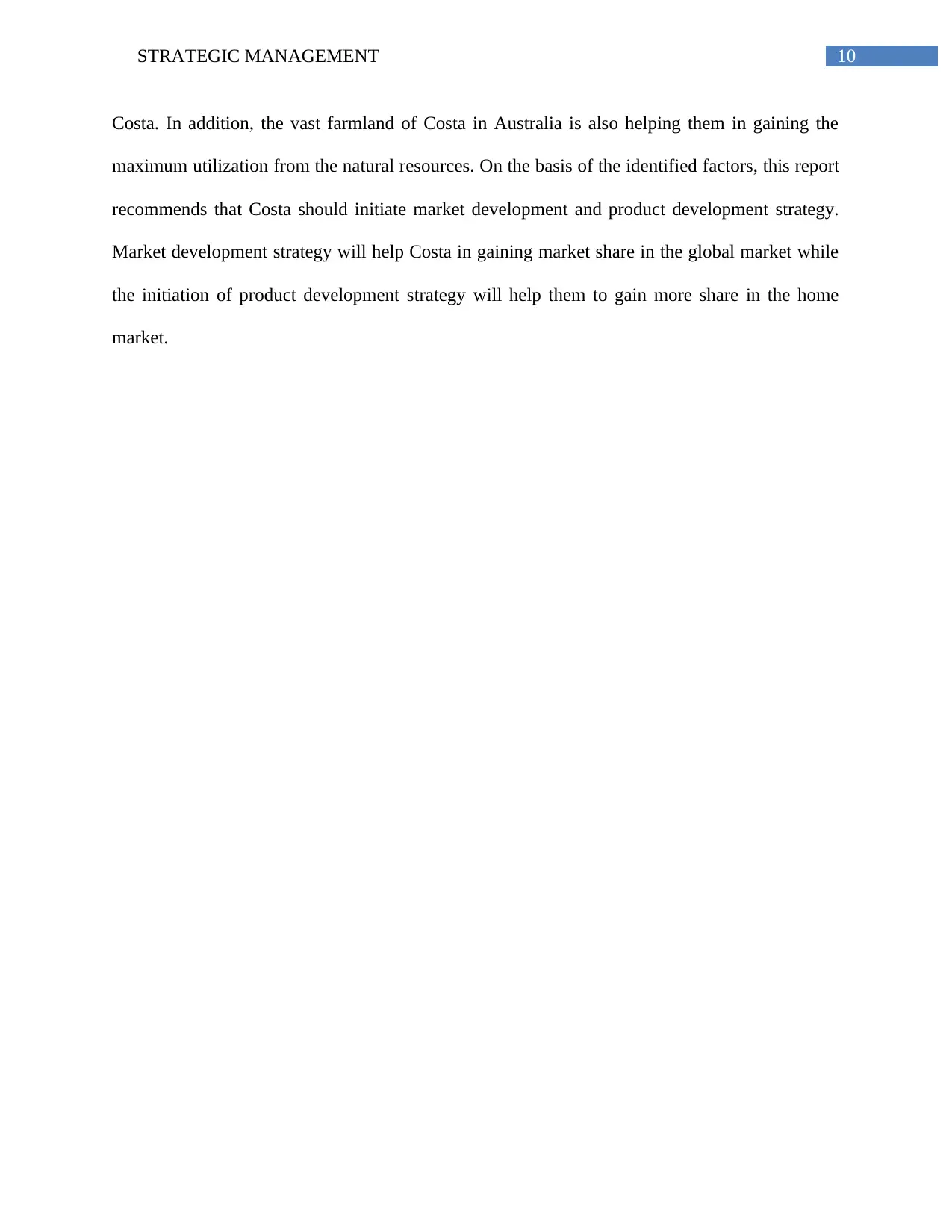
10STRATEGIC MANAGEMENT
Costa. In addition, the vast farmland of Costa in Australia is also helping them in gaining the
maximum utilization from the natural resources. On the basis of the identified factors, this report
recommends that Costa should initiate market development and product development strategy.
Market development strategy will help Costa in gaining market share in the global market while
the initiation of product development strategy will help them to gain more share in the home
market.
Costa. In addition, the vast farmland of Costa in Australia is also helping them in gaining the
maximum utilization from the natural resources. On the basis of the identified factors, this report
recommends that Costa should initiate market development and product development strategy.
Market development strategy will help Costa in gaining market share in the global market while
the initiation of product development strategy will help them to gain more share in the home
market.
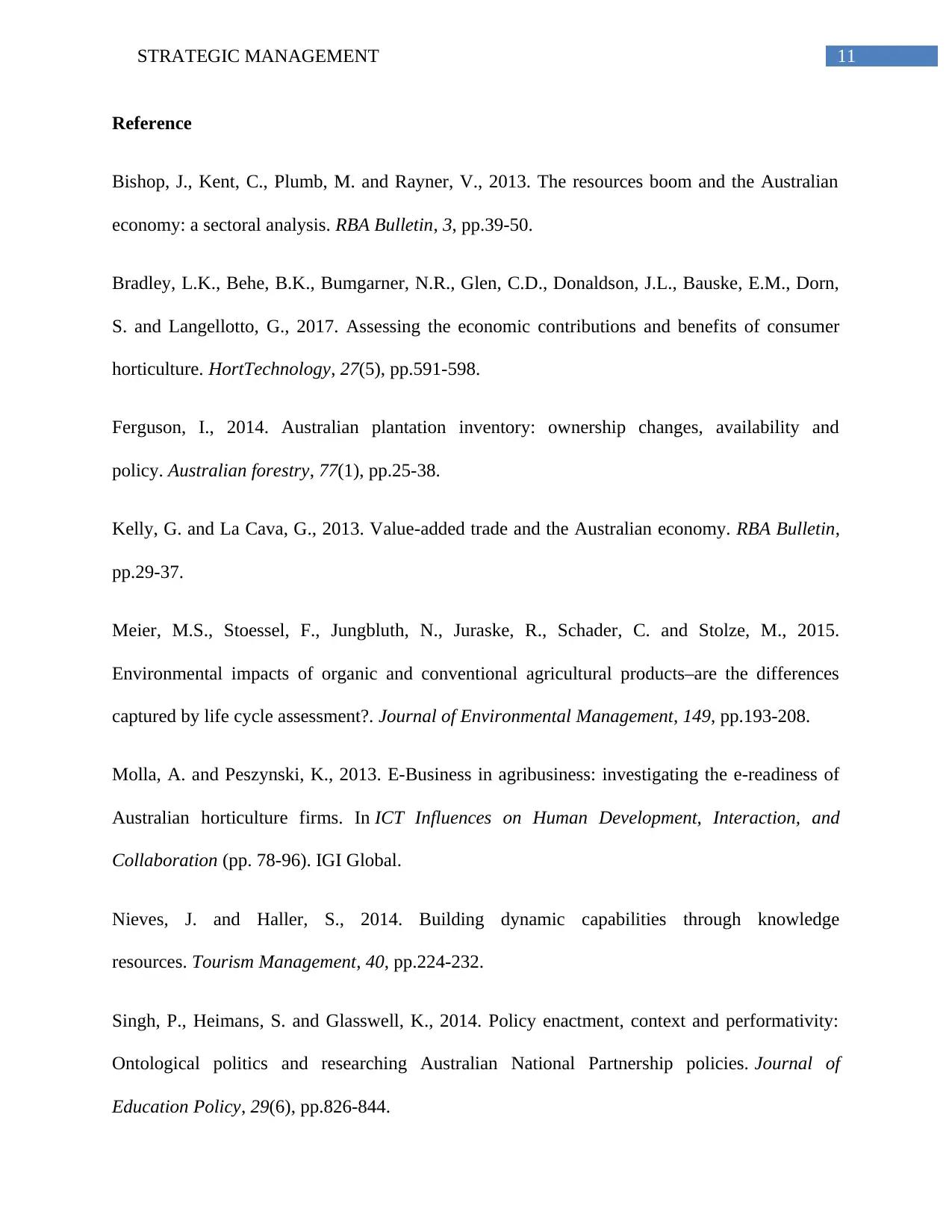
11STRATEGIC MANAGEMENT
Reference
Bishop, J., Kent, C., Plumb, M. and Rayner, V., 2013. The resources boom and the Australian
economy: a sectoral analysis. RBA Bulletin, 3, pp.39-50.
Bradley, L.K., Behe, B.K., Bumgarner, N.R., Glen, C.D., Donaldson, J.L., Bauske, E.M., Dorn,
S. and Langellotto, G., 2017. Assessing the economic contributions and benefits of consumer
horticulture. HortTechnology, 27(5), pp.591-598.
Ferguson, I., 2014. Australian plantation inventory: ownership changes, availability and
policy. Australian forestry, 77(1), pp.25-38.
Kelly, G. and La Cava, G., 2013. Value-added trade and the Australian economy. RBA Bulletin,
pp.29-37.
Meier, M.S., Stoessel, F., Jungbluth, N., Juraske, R., Schader, C. and Stolze, M., 2015.
Environmental impacts of organic and conventional agricultural products–are the differences
captured by life cycle assessment?. Journal of Environmental Management, 149, pp.193-208.
Molla, A. and Peszynski, K., 2013. E-Business in agribusiness: investigating the e-readiness of
Australian horticulture firms. In ICT Influences on Human Development, Interaction, and
Collaboration (pp. 78-96). IGI Global.
Nieves, J. and Haller, S., 2014. Building dynamic capabilities through knowledge
resources. Tourism Management, 40, pp.224-232.
Singh, P., Heimans, S. and Glasswell, K., 2014. Policy enactment, context and performativity:
Ontological politics and researching Australian National Partnership policies. Journal of
Education Policy, 29(6), pp.826-844.
Reference
Bishop, J., Kent, C., Plumb, M. and Rayner, V., 2013. The resources boom and the Australian
economy: a sectoral analysis. RBA Bulletin, 3, pp.39-50.
Bradley, L.K., Behe, B.K., Bumgarner, N.R., Glen, C.D., Donaldson, J.L., Bauske, E.M., Dorn,
S. and Langellotto, G., 2017. Assessing the economic contributions and benefits of consumer
horticulture. HortTechnology, 27(5), pp.591-598.
Ferguson, I., 2014. Australian plantation inventory: ownership changes, availability and
policy. Australian forestry, 77(1), pp.25-38.
Kelly, G. and La Cava, G., 2013. Value-added trade and the Australian economy. RBA Bulletin,
pp.29-37.
Meier, M.S., Stoessel, F., Jungbluth, N., Juraske, R., Schader, C. and Stolze, M., 2015.
Environmental impacts of organic and conventional agricultural products–are the differences
captured by life cycle assessment?. Journal of Environmental Management, 149, pp.193-208.
Molla, A. and Peszynski, K., 2013. E-Business in agribusiness: investigating the e-readiness of
Australian horticulture firms. In ICT Influences on Human Development, Interaction, and
Collaboration (pp. 78-96). IGI Global.
Nieves, J. and Haller, S., 2014. Building dynamic capabilities through knowledge
resources. Tourism Management, 40, pp.224-232.
Singh, P., Heimans, S. and Glasswell, K., 2014. Policy enactment, context and performativity:
Ontological politics and researching Australian National Partnership policies. Journal of
Education Policy, 29(6), pp.826-844.
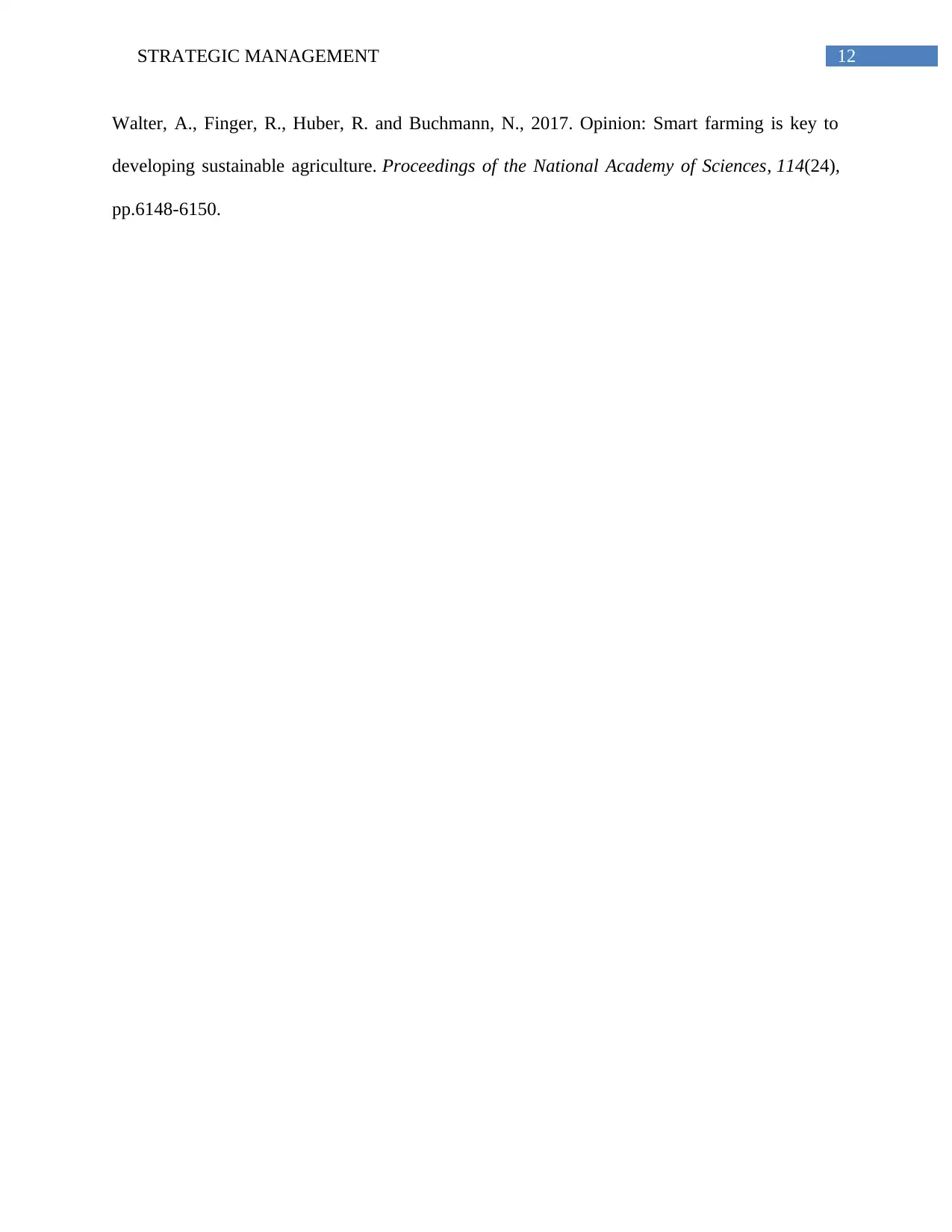
12STRATEGIC MANAGEMENT
Walter, A., Finger, R., Huber, R. and Buchmann, N., 2017. Opinion: Smart farming is key to
developing sustainable agriculture. Proceedings of the National Academy of Sciences, 114(24),
pp.6148-6150.
Walter, A., Finger, R., Huber, R. and Buchmann, N., 2017. Opinion: Smart farming is key to
developing sustainable agriculture. Proceedings of the National Academy of Sciences, 114(24),
pp.6148-6150.
1 out of 13
Related Documents
Your All-in-One AI-Powered Toolkit for Academic Success.
+13062052269
info@desklib.com
Available 24*7 on WhatsApp / Email
![[object Object]](/_next/static/media/star-bottom.7253800d.svg)
Unlock your academic potential
© 2024 | Zucol Services PVT LTD | All rights reserved.





